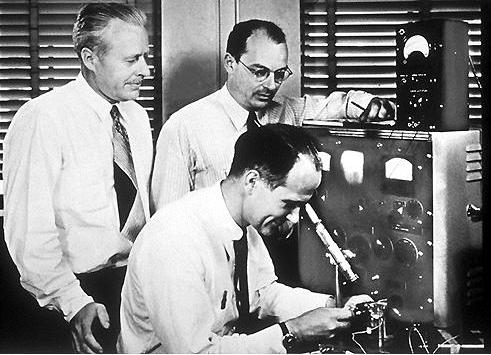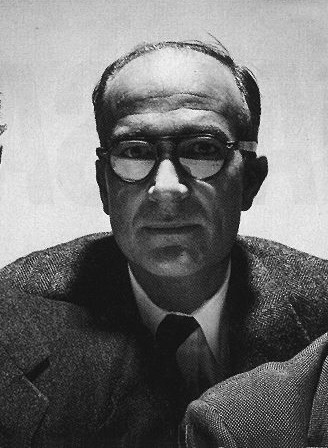The first months on Shockley’s Ph.D. production line were exhilarating. It wasn’t really a production line at all. Everything at this stage was research. Every day a dozen young Ph.D.’s came to the shed at eight in the morning and began heating germanium and silicon, another common element, in kilns to temperatures ranging from 1,472 to 2,552 degrees Fahrenheit. They wore white lab coats, goggles, and work gloves. When they opened the kiln doors weird streaks of orange and white light went across their faces, and they put in the germanium or the silicon, along with specks of aluminum, phosphorus, boron. and arsenic. Contaminating the germanium or silicon with the aluminum, phosphorus, boron, and arsenic was called doping. Then they lowered a small mechanical column into the goo so that crystals formed on the bottom of the column, and they pulled the crystal out and tried to get a grip on it with tweezers, and put it under microscopes and cut it with diamond cutters, among other things, into minute slices, wafers, chips; there were no names in electronics for these tiny forms. The kilns cooked and bubbled away, the doors opened, the pale apricot light streaked over the goggles, the tweezers and diamond cutters flashed, the white coats flapped, the Ph. D.’s squinted through their microscopes, and Shockley moved between the tables conducting the arcane symphony.
In pensive moments Shockley looked very much the scholar, with his roundish face, his roundish eyeglasses, and his receding hairline; but Shockley was not a man locked in the pensive mode. He was an enthusiast, a raconteur, and a showman. At the outset his very personality was enough to keep everyone swept up in the great adventure. When he lectured, as he often did at colleges and before professional groups, he would walk up to the lectern and thank the master of ceremonies and say that the only more flattering introduction he had ever received was one he gave himself one night when the emcee didn’t show up, whereupon – bango!- a bouquet of red roses would pop up in his hand. Or he would walk up to the lectern and say that tonight he was getting into a hot subject, whereupon he would open up a book and – whump! -a puff of smoke would rise up out of the pages.
Shockley was famous for his homely but shrewd examples. One day a student confessed to being puzzled by the concept of amplification, which was one of the prime functions of the transistor. Shockley told him: ‘If you take a bale of hay and tie it to the tail of a mule and then strike a match and set the bale of hay on fire, and if you then compare the energy expended shortly thereafter by the mule with the energy expended by yourself in the striking of the match, you will understand the concept of amplification.’
On November 1,1956, Shockley arrived at the shed on South San Antonio Road beaming. Early that morning he had received a telephone call informing him that he had won the Nobel Prize for physics for the invention of the transistor; or, rather, that he was co-winner, along with John Bardeen and Walter Brattain. Shockley closed up shop and took everybody to a restaurant called Dinah’s Shack over on El Camino Real, the road to San Francisco that had become Palo Alto’s commercial strip. He treated his Ph. D. production line and all the other employees to a champagne breakfast. It seemed that Shockley’s father was a mining engineer who spent years out on remote durango terrain, in Nevada, Manchuria and all over the world. Shockley’s mother was like Noyce’s. She was an intelligent woman with a commanding will. The Shockleys were Unitarians, the Unitarian Church being an offshoot of the Congregational. Shockley Sr. was twenty years older than Shockley’s mother and died when Shockley was seventeen. Shockley’s mother was determined that her son would someday ‘set the world on fire,’ as she once put it. And now he had done it. Shockley lifted a glass of champagne in Dinah’s Shack, and it was as if it were a toast back across a lot of hardwrought durango grit Octagon Soap sagebrush Dissenting Protestant years to his father’s memory and his mother’s determination.
That had been a great day at Shockley Semiconductor Laboratory. There weren’t many more. Shockley was magnetic, he was a genius, and he was a great research director–the best, in fact. His forte was breaking a problem down to first principles. With a few words and a few lines on a piece of paper he aimed any experiment in the right direction. When it came to comprehending the young engineers on his Ph.D. production line, however, he was not so terrific.
It never seemed to occur to Shockley that his twelve highly educated elves just might happen to view themselves the same way he had always viewed himself: which is to say, as young geniuses capable of the sort of inventions Nobel Prizes were given for. One day Noyce came to Shockley with some new results he had found in the laboratory. Shockley picked up the telephone and called some former colleagues at Bell Labs to see if they sounded right. Shockley never even realized that Noyce had gone away from his desk seething. Then there was the business of the new management techniques. Now that he was an entrepreneur, Shockley came up with some new ways to run a company. Each one seemed to irritate the elves more than the one before. For a start, Shockley published their salaries. He posted them on a bulletin board. That way there would be no secrets. Then he started having the employees rate one another on a regular basis. These were so-called peer ratings, a device sometimes used in the military and seldom appreciated even there. Everybody regarded peer ratings as nothing more than popularity contests. But the real turning point was the lie detector. Shockley was convinced that someone in the shed was sabotaging the project. The work was running into inexplicable delays, but the money was running out on schedule. So he insisted that one employee roll up his sleeve and bare his chest and let the electrodes be attached and submit to a polygraph examination. No saboteur was ever found.•


